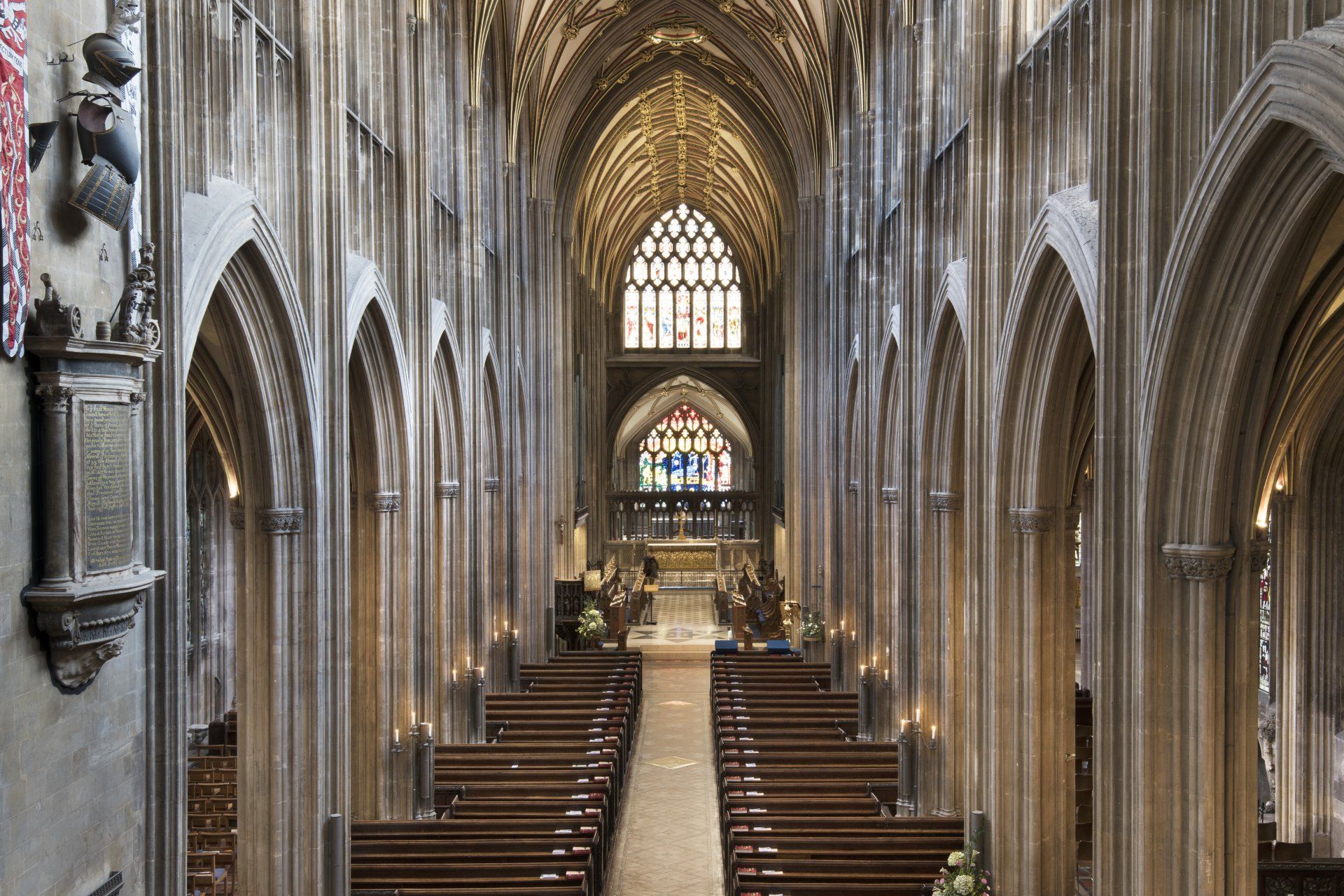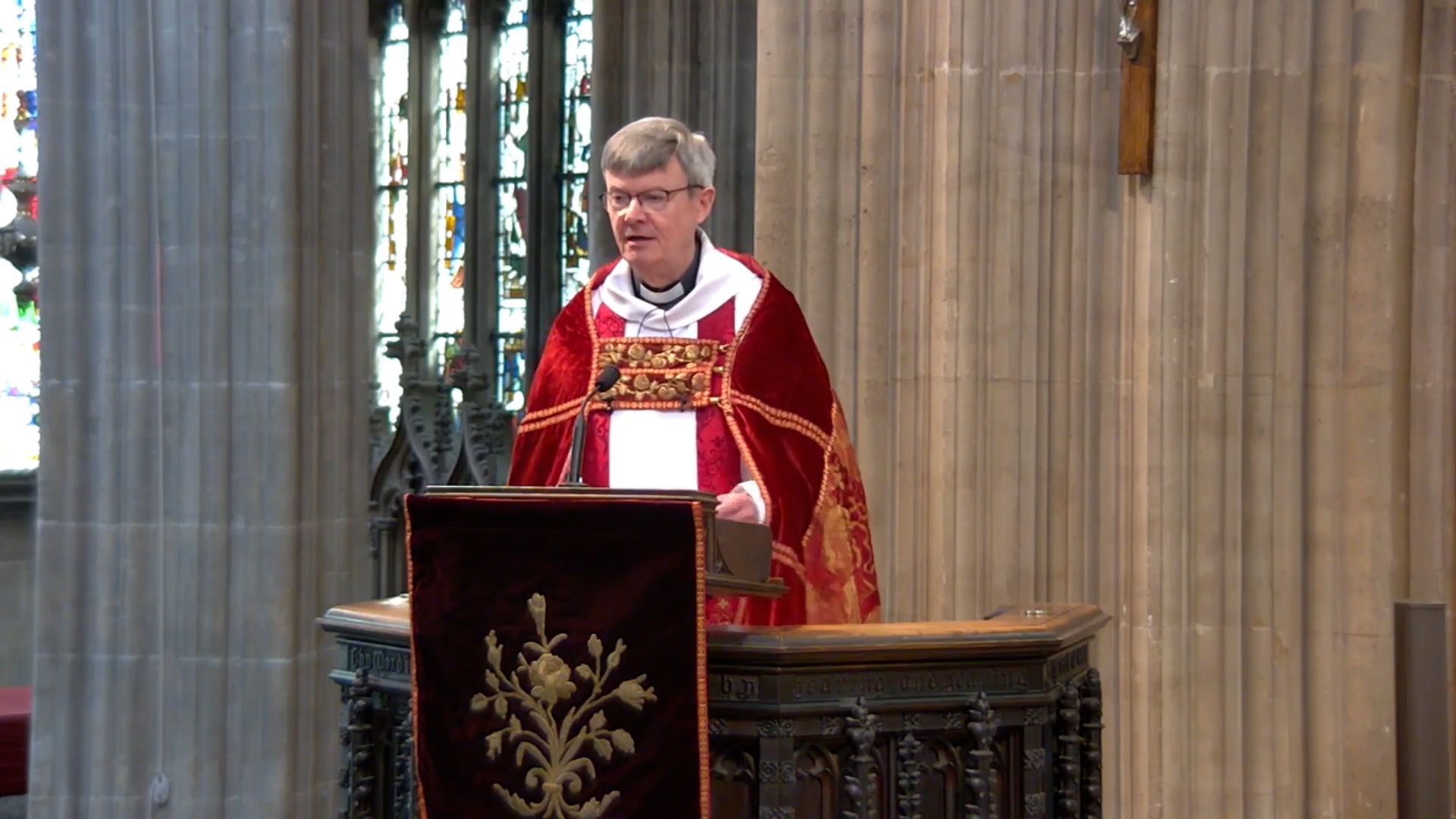West End of the Nave
A Breathtaking view
Take in the view down the length of the nave towards the chancel, altar and - beyond this - the Lady Chapel. The strong vertical emphasis of the towering pillars and soaring arches that draw the eye upwards to the spectacular rib vaulting, is characteristic of the Perpendicular style of English Gothic architecture.
Gothic architecture
The principal architectural style of the present church building is "Gothic, a style which flourished during the high and late medieval periods. It originated in 12th century France and lasted until the 16 century, when the Renaissance style superseded it. Characteristic features of Gothic architecture in churches are pointed arches, ribbed vaults (in the ceiling!), height and verticality and flying buttresses.
The practical function of the ribbed vaulting is to enable a heavy stone ceiling to span a large roof space. The vaulting spreads the thrust of the weight load outwards and down through the supporting pillars. The bosses act as keystones, locking the vaulting in place securely.
Pointed arches and the verticality of the Gothic style facilitate a wonderful sense of light and space - and draw the eye upwards, symbolically towards heaven. They also offer both real and proportional height, inside the building and out. The exterior effect facilitates the use of towers and spires - as most spectacularly demonstrated by Salisbury Cathedral in Wiltshire, which has the tallest spire in the UK at 404' (123m).
St Mary Redcliffe is a very light building. In part this is because the stone is light in colour but it is also because of the clerestory, the second level of the nave walls in which there are large clear glazed windows. This architectural feature has its origins in the architecture of ancient Rome and Greece (in those days without glazing). In churches it was often used in Roman basilicas and is a feature of the later Gothic style. (It has also been used in railway carriage designs - such as in the Great Western Railway's passenger carriage cupolas, where the roof windows provided access to and ventilation for the gas lighting).
Medieval font
Near the pillar to the right of the shop is a large 13th century stone font with an arcaded octagonal bowl and carved foliage beneath. Directly above, on the face of the pier, is a bracket in the form of a carved angel bearing a painted inscription. Traces of a second painted inscription are visible on the face of the pier itself. The font was relocated to the North Transept in 1762 and moved back to its original position in 1839.
In his Short Guide to St Mary Redcliffe (1921) the Rev Madan described the font, noting that, "suspended over the font is the gilt Dove which originally hung under the sounding board of the old pulpit."
Memorial to Admiral Sir William Penn (1621 - 1670)
Admiral William Penn's memorial, funerary armour, crest and replica pennants (together called "funeral achievements") are located high on the nave wall, to the right of the entrance to St John's Chapel form the west end of the nave. Penn was a Naval Commander, Naval Administrator and MP, who's son - the Quaker William Penn - founded Pennsylvania and wrote the following inscription, which can be found on his father's memorial tablet:
To the just Memory of Sr Will Penb Kt & sometimes Generall borne at Bristol In 1621 son of Captain Giles Penn, several yeares consul for ye English in ye Mediterranean of the Penns of Penns Lodge in ye County of Wilts, and those Penns of Penn in ye County of Bucks and by his Mother from the Gilberts in ye County of Somerset Originally from Yorkshire. Addicted from his youth to maritime affairs he was made Captain at ye yeares of 21. Rear-Admiral of Ireland at 23 Vice Admiral of Ireland at 25 Admiral to ye Straightes at 29 Vice-Admiral of England at 31, and General in the first Dutch Warres, at 32. Whence retiring, in 1665 he was chosen a Parliament man for the Town of Weymouth, 1660 ; made Commissioner of the Admiralty and Navy ; Governor of the Town and Fort of King-sail; Vice-Admiral of Munster, anda Member of that Provincial Counseill ; and in Anno 1664, was chosen Great Captain Commander under his Royall Highnesse in ye Signall and most evidently successful fight against the Dutch fleet. Thus, He took leave of the sea, his old element ; But continued still his other employs till 1669 ; at what time, through bodily I=infirmities (contracted by ye care and fatigue of public affairs), He withdrew, prepared and made for his end ; and with a gentle and Even Gale, in much peace, arrived and anchored in his Last and Best Port, at Wanstead in ye County of Essex, ye 16 Sept. 1670, Being then but 49 and 4 months old. To whose Name and merit his surviving Lady hath erected this remembrance.
Penn's Biography
Admiral Sir William Penn was born in the parish of St Thomas the Martyr, Bristol (the neighbouring parish to St Mary Redcliffe) in 1621. He was the son of the sea captain Giles Penn and his wife Joan Penn (maiden name Gilbert) who married at St Mary Redcliffe. William Penn was appointed as a captain in the Royal Navy in 1643 at the age of 22. On 6 June in the same year he married a Dutch widow, Margaret Van der Schure, at St-Martin-within-Ludgate, 40 Ludgate Hill, London (near Margaret's family home in The Strand). The officiant at the wedding is recorded in the church's records and in a certificate at the City of London Guildhall as: "Mr Dyke, Lecturer" The title 'Lecturer' indicates a holder of a stipend for preaching - ie a Puritan officiated at the wedding, rather than the Anglican clergyman appointed to serve in that church. The newly weds lived in Tower Gardens, in two rooms of navy quarters. After Penn was promoted in 1644 they moved into a house owned by King Charles II and it was in this house that their son William was born on 14 October 1644.
Penn's naval career took him away from home for long periods. However when he did have time back in London it seems he enjoyed life to the full. Samuel Pepys, diarist and a colleague of Penn senior when Penn moved to a role at the Admiralty, records that Penn senior indulged, "drinking the susceptible into a stupor, singing bawd songs and supping at midnight oft bread-and-butter on the roof." Pepys also described Admiral Penn as "a very merry fellow" and records Penn's wife, Margaret, in a similar light, her pranks apparently included,"flinging Pepys on a bed at a party and heaping female guests upon him."
The Penn family's personal wealth grew, presumably assisted by Penn's ever more successful naval career and also the income from his wife's land holdings in Ireland, which Penn successfully petitioned Oliver Cromwell to restore to her (this was done by an Order in Council dated 1 September 1654.
When the Great Plague hit London in 1655, the Penns moved to safer lodgings in Woolwich. By this time Penn was working at the Navy Board. The family acquired a country house at Walthamstow, where their close friend Sir William Batten, a Bristolian who was a Surveyor of the Navy, also had a home. Penn and Batten often entertained Samuel Pepys.
In 1669 Penn resigned from the Navy Board and the family moved permanently to the countryside, living at Wanstead. Here. Admiral Sir William Penn died on 16 September 1670.
His will stated that his body should be buried in St Mary Redcliffe Church, "as near unto the body of my deare Mother deceased whose body lyes there interned as the same conveniently may And my will is that there shall be erected in the said church as near unto the place where my body shall bee buried as the same can be contrived A Hansome and Decent Tombe to remain as a monument as well for my said Mother as for my Self."
Penn's naval career
William Penn was appointed as a captain in the Royal Navy in 1643 at the age of 22. From 1642 - 1651 during the English Civil Wars Penn served in the Parliamentarian Navy as senior commander. When he was not at sea during this period, he lived with his family in London. During the conflict his home city of Bristol was attacked by Royalist forces led by Prince Rupert (the German nephew of Charles I). Rupert's forces robbed, sacked and burned homes, turning out many from their houses.
Penn was appointed Rear Admiral of the Irish Seas in 1647.
He was arrested in 1648 on suspicion of corresponding with King Charles I but was soon released.
Penn fought in the first Anglo-Dutch War 1652 - 1654.
In 1654 he secretly offered the fleet to the exiled King Charles II.
He then commanded the expedition sent by Oliver Cromwell to the West Indies which, in May 1655, captured Jamaica from the Spanish. This enabled the island to become the centre of English slave trading and sugar production. Penn became its first governor and this added to his personal wealth.
However, at the Siege of Santo Domingo of 1655, during a major battle fought between April 23 to April 30, 1655 at the Spanish Colony of Santo Domingo (Hispaniola), a force of 2,400 Spanish troops, led by Governor Don Bernardino Menses and Bracamonte, Count of Peñalba, defeated a force of 13,120 troops and 34 ships of the English Commonwealth Navy led by Admiral Sir William Penn. On his return to Britain Penn was briefly imprisoned, for reasons that are not clear.
He retired to the family's restored Irish estates for a while, engaging in secret correspondence with the Royalists.
Post-restoration
After Cromwell's death and the Restoration of the Crown in 1660, Penn offered the fleet to King Charles II and gained the King's favour, knighthood and appointment as a commissioner for the Navy (an extraordinary turn of events, given that he had been one of the most senior Parliamentarian naval commanders).
Penn's role as a commissioner for the Navy led him to work with Samuel Pepys at the Admiralty, where Pepys was Penn's deputy. Apparently they argued a good deal - but together they reformed the structure and administration of the navy, laying the foundations for Britain's later dominance of the seas and arguably of the British Empire.
Penn loaned most of his personal fortune to help fund the King's ambitious naval building programme.
In the Second Dutch War (1665 - 1667) Penn served as Captain of the Fleet with the Duke of York (the future King James II). Penn wrote the code of naval tactics that was the basis of the "Duke of York's Sailing and Fighting Instructions" which was for a long time the orthodox tactical guide for the Royal Navy.
Pennsylvania
Penn's son, William Penn the younger, was a leading and, according to contemporary commentators, a troublesome' Quaker. After his father's death in 1670, he asked the monarch to repay the debt but the cash strapped King could not do so. So he offered Penn the younger land in America to redeem the debts. Penn the younger wanted to name this territory "Sylvania" but the King insisted that should be prefaced "Penn" in honour of the Admiral. Thus the state of Pennsylvania came into being. Its arms still incorporate those of the man whose name it bears.
Penn's funeral achievements
It was the custom of the day for a set of funeral achievements like these to be carried as part of the formalities attaching to the funeral of a major figure. These items were originally in the south transept. they were moved to the present position as part of the Victorian restoration of the church.
When conservation works were done on these items during 1996 - 1998 the original silk banners were found to be in a very poor and fragile state - as little as 10% of one remained inside the outer netting that had been put around both in the 19 century. So they were conserved and are now held in secure storage. The striking designs for the two new replicas were carefully researched from the remains of the originals, by reference to drawings in the famous Braikenridge Collection in the Bristol Museum and Art Gallery and with advice from the Norroy and Ulster King of Arms at the College of Heralds. The banners were hand made by Turtle and Pearce Ltd in double thickness heavy polyester/cotton material with embroidery stitching (rather than painted silk like the originals) for better durability.
The armour is unusual in that it is complete - helmet, breastplate and even spurs.



